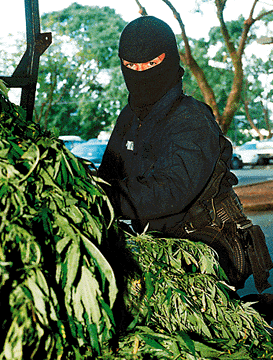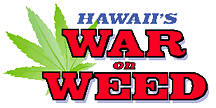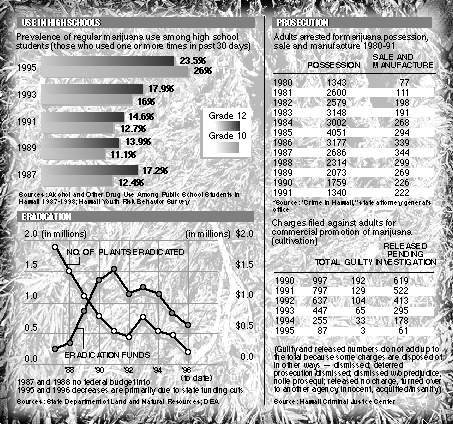
A Hilo police officer in a ski mask unloads confiscated
marijuana plants from a truck. A 10-year crackdown has
rid the state of 6.3 million pakalolo plants.
Photo by Ken Sakamoto, Star-Bulletin

A Hilo police officer in a ski mask unloads confiscated
marijuana plants from a truck. A 10-year crackdown has
rid the state of 6.3 million pakalolo plants.
Photo by Ken Sakamoto, Star-Bulletin
By Joan Conrow and Jim Witty
Star-Bulletin
Now, after nearly two decades of Green Harvest, Operation Wipe-Out and other aggressive eradication programs, Hawaii's homegrown is expensive and scarce.
 An industry once worth an estimated $1 billion to $10 billion a year - surpassing in 1989 the value of sugar, pineapple and tourism - has been crippled, driven indoors and even underground.
An industry once worth an estimated $1 billion to $10 billion a year - surpassing in 1989 the value of sugar, pineapple and tourism - has been crippled, driven indoors and even underground.
"Now we're in the controlled maintenance mode," said Bob Aiu, the Drug Enforcement Administration's lone full-time marijuana eradication agent in Hawaii. "But you stop maintaining for six months and it will get out of control. . . . It was a major problem. People tend to forget that."
The success of the program is measured in the decline in outdoor patch seizures and the increase in indoor growing operations.
But some people are starting to ask what price has been paid for that success, while others question what the clampdown on cultivation has achieved - besides ridding the state of a reported 6.3 million pakalolo plants.
Few marijuana growers have been convicted.
Marijuana use among Hawaii teen-agers has risen.
And many blame marijuana eradication for the rise in use of harder drugs.
"It should really be evaluated in terms of accountability and effectiveness, in addition to our real goal, which is reducing substance abuse in the state," said state Rep. David Tarnas of the Big Island.
Researchers with the University of Hawaii's Social Science Institute said such an evaluation is hampered by the absence of an explicit policy with clearly defined goals and objectives, as well as incomplete data on eradication's full costs.
"Because of this vagueness, it makes it difficult to analyze the program and prioritize things," said the Institute's James White.
"There's no evaluation other than numbers of plants and no examination of its consequences, either intentionally or otherwise," said institute Director Donald Topping.
A 1990 state auditor's report had a similar complaint about Hawaii's drug enforcement effort, noting that it lacked a written statewide strategy that "is systematic, thoughtful and comprehensive." Instead, it relied on "unsystematic, intermittent planning geared to federal funding."
In a 1989 report, "A Survey of Hawaii's War on Drugs," former state Attorney General Warren Price makes a case for declaring the state a high-intensity drug trafficking area, which would garner more funding, because of a marijuana trade that "grew from a 'back yard problem' to the largest industry in Hawaii in just a few years."
Price, whose highly successful Operation Wipe-Out brought the military and Drug Enforcement Administration deeply into the state's eradication efforts, declined to be interviewed.
But in the report, he advocated a massive border interdiction and field enforcement effort, saying such federal aid was warranted because "it is the national demand that has created this problem for Hawaii."
Local residents were also clamoring for pakalolo.
The report states that marijuana is "clearly the largest dealt and used drug in the state," prompting the crackdown.
"The objective of any anti-drug strategy is to reduce consumption," the report states. "One certain way to reduce consumption is to reduce the supply of drugs."
But despite a dramatic drop in the supply of Hawaiian homegrown, use among high school students has increased since 1987, when eradication shifted into high gear. The biggest rise was among 10th-graders, with 24 percent reporting they smoked pot regularly in 1995, compared with 12.4 percent in 1987.
"Oh, you can still get pot pretty easily," said one north shore Kauai man. "Only now it's grown in a basement in New Jersey."
Law enforcement officials and marijuana sellers agree the state is now importing buds from California, Arizona, Oregon, Washington, Mexico and other places - a practice unheard of before 1990.
The crop usually fetches the same high prices as locally grown pakalolo.
With decreased supply and continued strong demand, the value of Hawaii-grown marijuana has skyrocketed from $1,600 a pound wholesale in 1987 to $8,000 today.
It's worth even more when split into smaller quantities for resale, especially in mainland states, according to police and dealers.
Law enforcement officials believe the high cost of the weed discourages cash-strapped consumers from smoking.
But the hefty price tag also makes Hawaii's crop worth more to those who barter it for a smokable form of crystal methamphetamine known as "ice."
"A lot of marijuana being commercially produced is traded for ice and exported for harder drugs," said Maui vice Capt. Paul Winters. "That's our frustration."
Although enforcement officials have used such sophisticated techniques as military photo-mapping and helicopter-mounted herbicide sprayers to wipe out Hawaii's pot crop, growers have responded with their own innovations.
Winters said growers have developed "90-day wonders" - small, bushy plants that mature quickly. They've also moved their operations indoors and underground. Growers interviewed on Kauai and Maui said they still plant largely outdoors, but in much smaller patches.
The numbers of plants confiscated has dropped sharply, from a high of 1.9 million in 1987 to about 200,000 so far this year.
With increased grower sophistication born of intense eradication pressure, law enforcement is spending more time staking out patches and making arrests. But translating charges into jail time is another matter.
Between 1990 and 1995, the state filed 3,220 counts of commercial promotion of marijuana - the most common charge against pot growers - against adults in Hawaii. Just 526 counts resulted in guilty convictions, while 2,088 counts are pending investigation.
"It's very frustrating that dealers and growers get arrested and don't get sent to prison," said Hawaii County vice chief Chad Fukui. "It's frustrating but we keep doing it. As long as it's against the law, we'll attack the problem with zeal."
